Player feedback plays a crucial role in the development of game mechanics, offering valuable insights into user experiences and preferences. By leveraging diverse channels for collecting reviews, developers can gain a comprehensive understanding of player sentiments, enabling them to make informed adjustments that enhance gameplay and overall satisfaction.
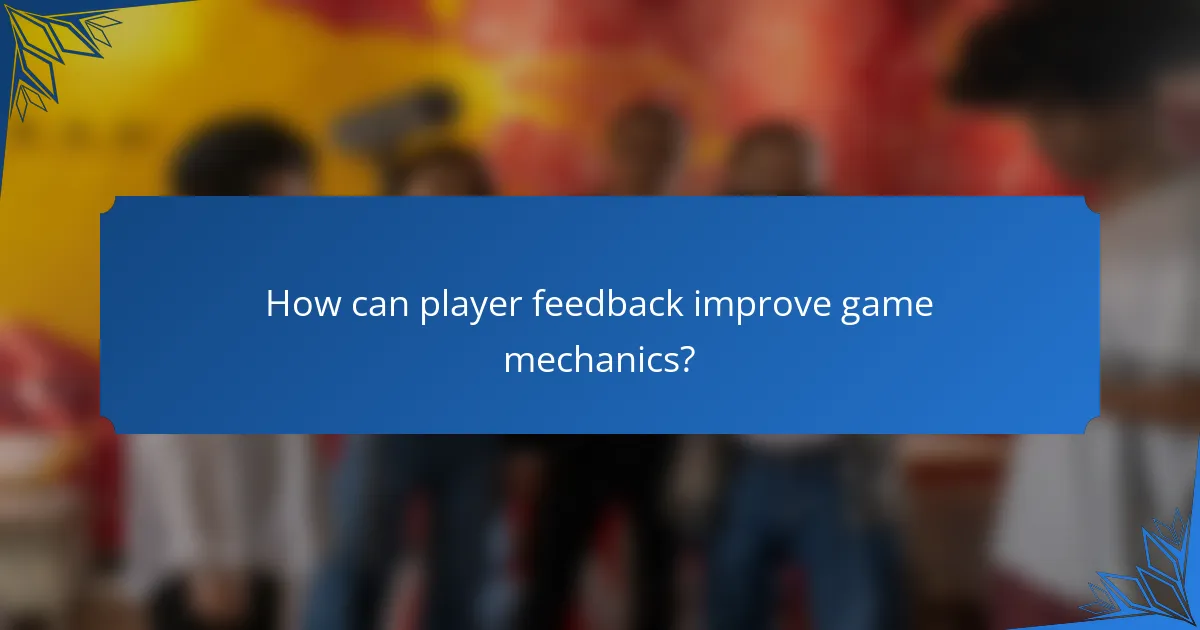
How can player feedback improve game mechanics?
Player feedback is essential for refining game mechanics, as it provides insights into user experiences and preferences. By actively listening to players, developers can make informed adjustments that enhance gameplay and overall satisfaction.
Increased player engagement
When players feel their feedback is valued, their engagement with the game increases. This can lead to a more dedicated player base, as users are more likely to invest time and resources into a game that reflects their input.
For example, incorporating player suggestions for new features or adjustments can create a sense of ownership among the community, fostering loyalty and encouraging ongoing participation in discussions and updates.
Enhanced game balance
Player feedback can highlight areas where game mechanics may be unbalanced, such as overpowered characters or ineffective strategies. By analyzing this input, developers can make targeted adjustments to ensure a fair and enjoyable experience for all players.
Regularly reviewing player comments and data can help identify trends, allowing developers to implement changes that improve balance without alienating any segment of the player base. For instance, adjusting character abilities based on player performance metrics can lead to a more competitive environment.
Targeted updates based on player input
Feedback allows developers to prioritize updates that address specific player concerns, leading to more effective and relevant improvements. This targeted approach ensures that resources are allocated efficiently, focusing on what players truly want and need.
For example, if a significant number of players report issues with a particular level or mechanic, developers can prioritize fixes for that area, rather than implementing broad changes that may not resonate with the community. This strategy not only improves gameplay but also demonstrates responsiveness to player needs.
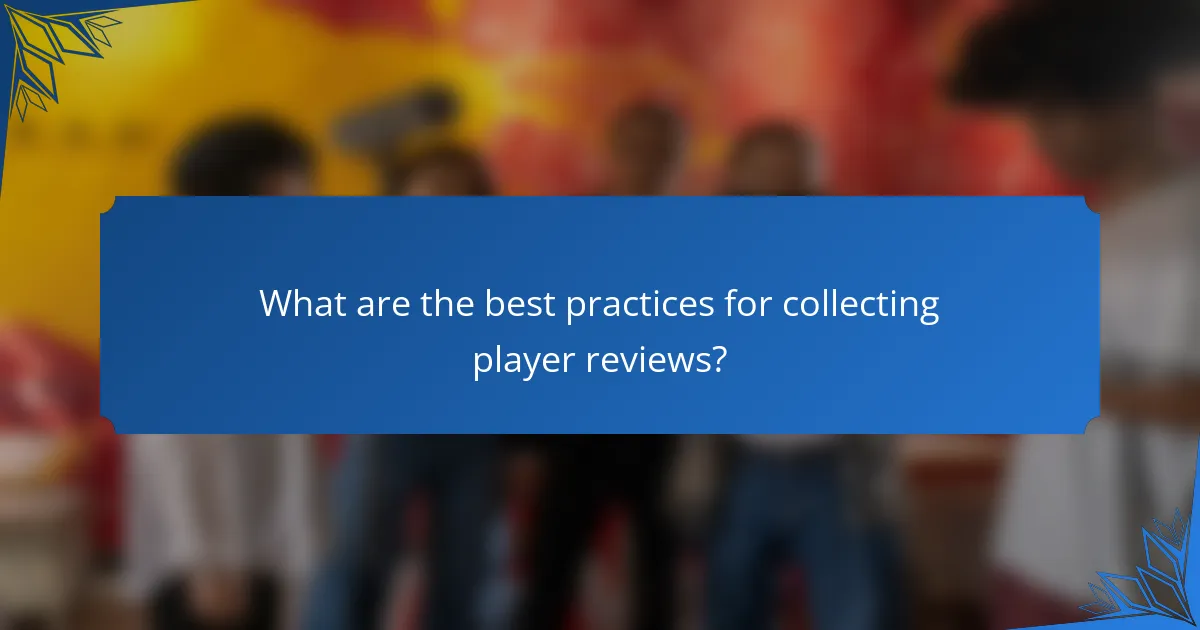
What are the best practices for collecting player reviews?
Collecting player reviews effectively involves using multiple channels to gather diverse feedback. Best practices include utilizing in-game surveys, engaging with community forums, and leveraging social media platforms to ensure a comprehensive understanding of player experiences.
Utilizing in-game surveys
In-game surveys are a direct method to collect player feedback while they are actively engaged with the game. These surveys can be short and targeted, focusing on specific aspects such as gameplay mechanics, graphics, or overall enjoyment. Aim for a completion time of under two minutes to maximize response rates.
Consider offering incentives, like in-game currency or exclusive items, to encourage participation. Ensure that the surveys are easily accessible and that players are informed about how their feedback will be used to improve the game.
Engaging with community forums
Community forums provide a platform for players to discuss their experiences and share insights. Actively participating in these forums allows developers to understand player sentiments and identify common issues. Regularly monitor threads and respond to player concerns to foster a sense of community and trust.
Encourage players to provide detailed feedback by asking specific questions or creating dedicated threads for particular topics. This can help streamline the feedback process and make it easier to analyze responses.
Leveraging social media platforms
Social media platforms are essential for reaching a broader audience and gathering informal feedback. Utilize channels like Twitter, Facebook, and Instagram to post polls, ask questions, and encourage players to share their thoughts. This approach can yield quick insights into player preferences and trends.
Be proactive in responding to comments and messages, as this engagement can enhance player loyalty. Additionally, consider using social media analytics tools to track sentiment and identify recurring themes in player feedback.
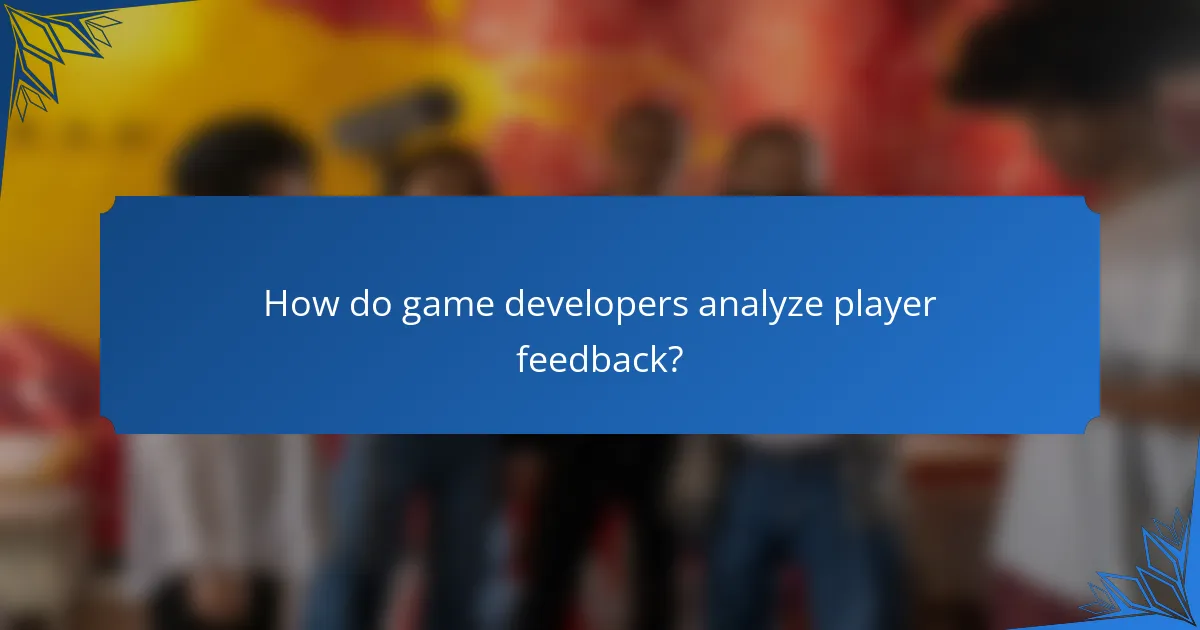
How do game developers analyze player feedback?
Game developers analyze player feedback through various methods to enhance gameplay and user experience. This involves collecting data from multiple sources, interpreting player sentiments, and tracking behaviors to inform design decisions.
Data analytics tools
Data analytics tools are essential for game developers to gather and interpret player feedback effectively. These tools can process large volumes of data from player interactions, such as in-game actions, session lengths, and purchase behaviors. Popular tools include Google Analytics, Mixpanel, and Unity Analytics, which provide insights into player engagement and retention rates.
When using data analytics, developers should focus on key performance indicators (KPIs) relevant to their game, such as average session duration or user churn rate. This helps identify areas needing improvement and informs future updates or game mechanics.
Sentiment analysis software
Sentiment analysis software helps developers gauge player opinions by analyzing text feedback from forums, reviews, and social media. By employing natural language processing (NLP), these tools can categorize sentiments as positive, negative, or neutral, providing a clearer picture of player satisfaction. Tools like MonkeyLearn and Lexalytics are commonly used for this purpose.
To maximize the effectiveness of sentiment analysis, developers should regularly monitor player feedback across various platforms. This ongoing assessment can reveal trends and emerging issues, allowing for timely responses and adjustments to game design.
Player behavior tracking
Player behavior tracking involves monitoring how players interact with a game to identify patterns and preferences. This can include tracking in-game choices, completion rates, and areas where players struggle or excel. Tools like Hotjar and GameAnalytics are useful for visualizing player journeys and pinpointing friction points.
Developers should implement behavior tracking from the early stages of game development to gather baseline data. This information can guide design decisions and enhance player experiences by addressing common pain points or optimizing popular features.

What are common player feedback themes?
Common player feedback themes often revolve around gameplay mechanics, graphics and performance, and storyline and character development. Understanding these themes helps developers identify areas for improvement and enhance the overall gaming experience.
Gameplay mechanics issues
Players frequently report issues related to gameplay mechanics, such as controls that feel unresponsive or overly complicated. These concerns can lead to frustration and impact overall enjoyment. Developers should prioritize user-friendly controls and intuitive mechanics to ensure a smoother gaming experience.
Another common issue is balancing, where certain characters or abilities may be perceived as overpowered or underpowered. Regular updates and community feedback can help maintain balance, ensuring fair competition among players.
Graphics and performance concerns
Graphics and performance are critical aspects that players often highlight in their feedback. Issues such as frame rate drops, long loading times, and visual glitches can detract from immersion. Developers should aim for consistent performance across various hardware configurations to cater to a wider audience.
Players also appreciate high-quality graphics that enhance the visual storytelling of a game. Regular optimization updates can help improve performance while maintaining visual fidelity, ensuring a satisfying experience for players.
Storyline and character development
Engaging storylines and well-developed characters are essential for player investment. Feedback often indicates that players seek deeper narratives and relatable characters that evolve throughout the game. Developers should focus on crafting compelling plots and character arcs that resonate with players.
Additionally, players may express a desire for more choices that affect the storyline. Implementing branching narratives can enhance replayability and allow players to feel a greater sense of agency in their gaming experience.
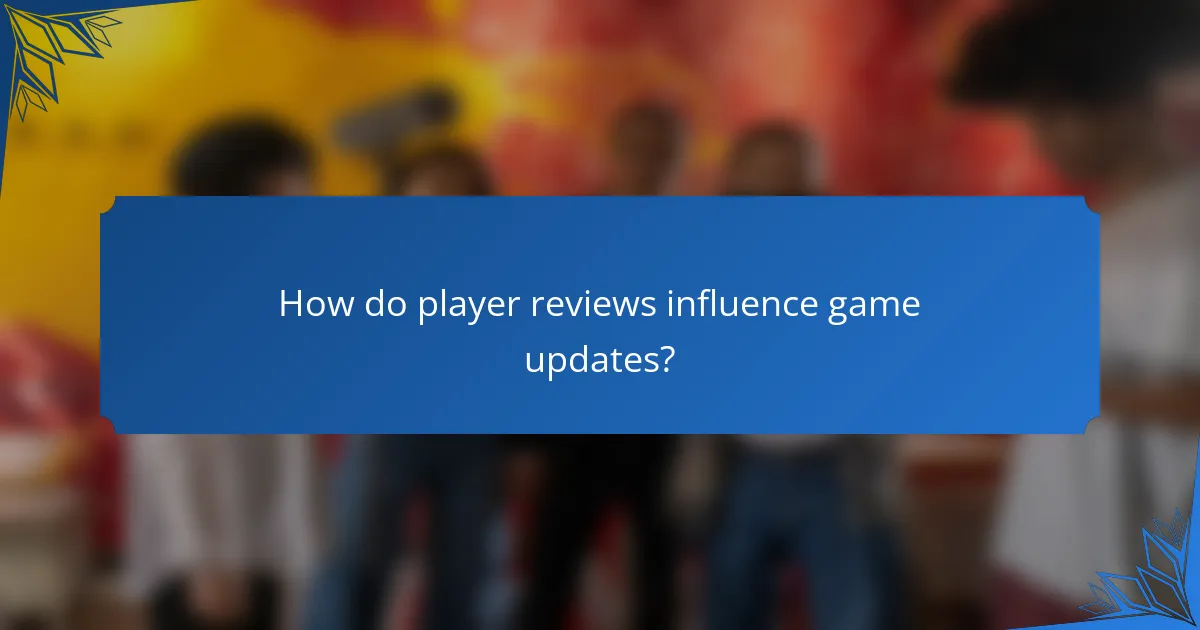
How do player reviews influence game updates?
Player reviews significantly shape game updates by providing developers with direct feedback on issues, desired features, and overall gameplay experience. This input helps prioritize changes that enhance player satisfaction and retention.
Prioritizing bug fixes
Bug fixes are often the most immediate response to player reviews. Developers analyze feedback to identify critical issues that disrupt gameplay, such as crashes or glitches. Addressing these problems quickly can improve player trust and satisfaction.
For example, if multiple players report a specific bug that affects game progression, developers may prioritize fixing it in the next update. Regular communication about fixes can also reassure players that their feedback is valued.
Implementing new features
Player reviews frequently highlight requests for new features that can enhance gameplay. Developers can use this feedback to guide the addition of content, such as new game modes or customization options. Prioritizing features that resonate with a large portion of the player base can lead to increased engagement.
For instance, if players express a desire for multiplayer options, developers might allocate resources to implement this feature in future updates. Tracking trends in feedback can help identify which features are worth pursuing.
Adjusting difficulty levels
Difficulty adjustments are a common response to player feedback, especially when reviews indicate that a game is too easy or too challenging. Developers can analyze player performance data alongside reviews to find a balanced difficulty that appeals to a wider audience.
For example, if many players find a particular level excessively difficult, developers might consider tweaking enemy strength or providing additional resources. Regularly updating difficulty based on player input can help maintain a fair and enjoyable experience for all players.
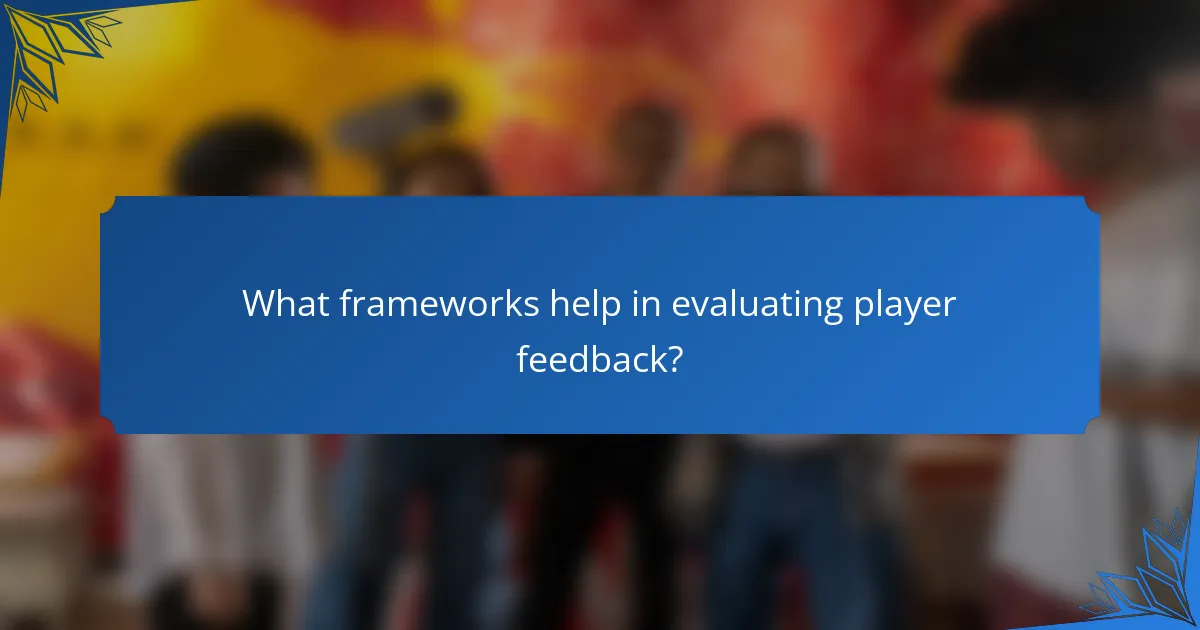
What frameworks help in evaluating player feedback?
Several frameworks can effectively evaluate player feedback, providing insights into player experiences and areas for improvement. These frameworks help developers understand player sentiments and prioritize changes based on user input.
Feedback categorization matrix
The feedback categorization matrix organizes player feedback into distinct categories, such as bugs, gameplay mechanics, and user interface issues. This structure allows developers to quickly identify the most pressing concerns and address them systematically.
To create a feedback categorization matrix, start by listing common feedback themes and assigning them to categories. For example, categorize feedback about game balance under “gameplay mechanics” and technical issues under “bugs.” This helps prioritize fixes based on frequency and severity.
Player satisfaction index
The player satisfaction index quantifies player satisfaction through surveys or in-game metrics, providing a clear measure of how players feel about the game. This index can be calculated using various factors, including gameplay enjoyment, ease of use, and overall experience.
To develop a player satisfaction index, consider using a Likert scale (e.g., 1 to 5) for players to rate their experiences. Regularly track these ratings to identify trends and areas needing improvement. Aim for a satisfaction score above 75% to indicate a generally positive player experience.
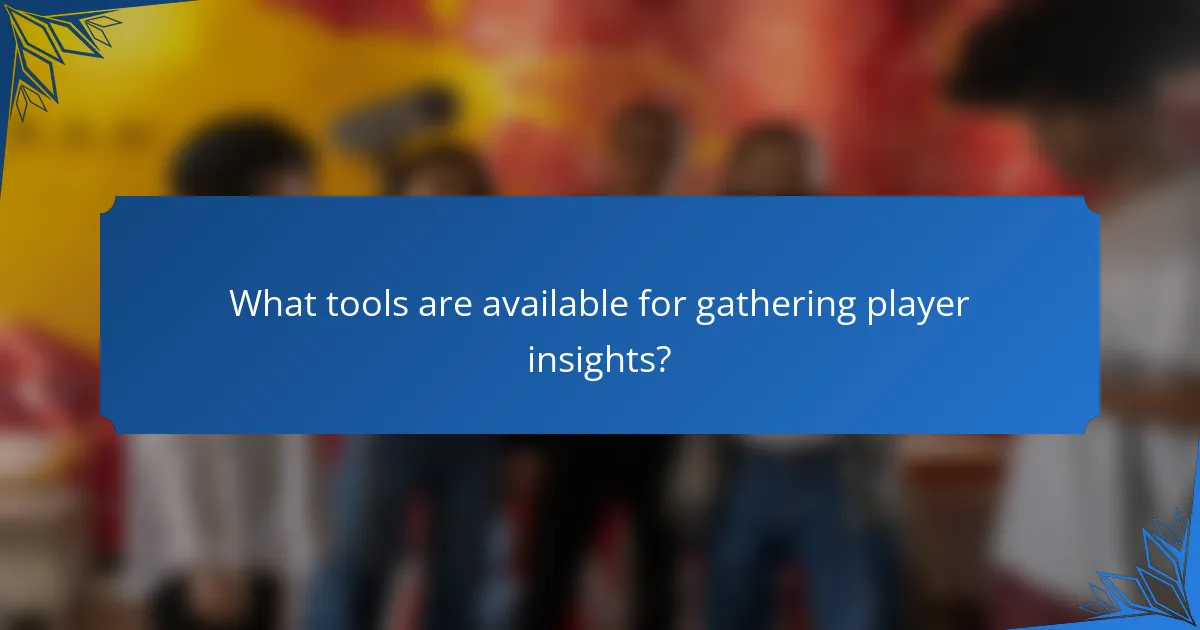
What tools are available for gathering player insights?
Various tools exist for gathering player insights, including surveys, analytics software, and community feedback platforms. These tools help developers understand player preferences, behaviors, and areas for improvement.
Surveys and Questionnaires
Surveys and questionnaires are effective for collecting direct feedback from players. They can be distributed via email, in-game prompts, or social media. Keep questions concise and focused to encourage higher response rates.
Consider using a mix of open-ended and multiple-choice questions to capture both qualitative and quantitative data. Aim for a completion time of under five minutes to maintain engagement.
Analytics Tools
Analytics tools track player behavior and interactions within the game. These tools can provide insights into player retention, session length, and in-game purchases. Popular options include Google Analytics, Unity Analytics, and Mixpanel.
When implementing analytics, ensure you respect player privacy and comply with regulations like GDPR. Use the data to identify trends and make informed decisions about game design and features.
Community Feedback Platforms
Community feedback platforms, such as forums and social media, allow players to share their thoughts and experiences. Engaging with players on these platforms can foster a sense of community and provide valuable insights.
Monitor discussions and actively participate to show players their opinions matter. Tools like Discord or Reddit can facilitate real-time feedback and discussions, helping developers stay in tune with player sentiment.



